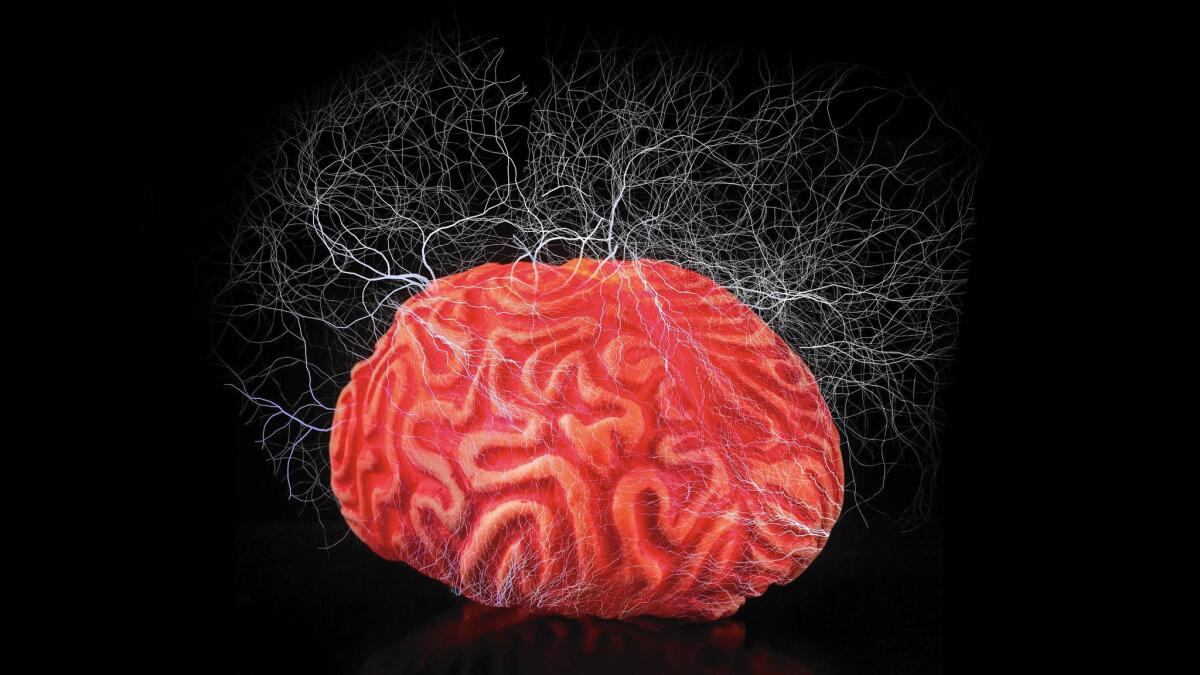Would you let someone zap your brain? Why ‘electronic brain stimulation’ is trending

Research on electrical stimulation at points on the skull has led to excitement over devices that deliver tDCS, transcranial direct current stimulation.
Focused thinking, better memory, deeper sleep, relief from depression, reduced stress: There is, if you believe what you read on the Internet, virtually no end to the benefits of electronic stimulation for the mind and brain. In particular, a technique called transcranial direct current stimulation is getting loads of attention from early adopters who rave about its potential and scientists who are trying to unravel what it can and cannot do.
The concept is simple: tDCS devices — available online or built with a 9-volt battery and other simple parts for as little as $10 — deliver weak electric currents to the skull with the goal of boosting activity in carefully chosen areas of the brain. And while some intriguing studies have fed speculation about a future fueled by drug-free brain enhancement, researchers urge caution. The field is still new, and there are many unknowns.
“It’s conceptually very attractive,” says Michael Nitsche, a neurophysiologist at the University Medical Center in Goettingen, Germany. “But tDCS is not Jesus in the way that you just put it on your head and it cures everything or makes everything better.”
Here is a look at what the science says so far.
The basics
Using electricity to alter the brain is an ancient idea. The Romans did it more than two milleniums ago, using the stunning effects of torpedo fish, a.k.a. electric rays, to treat headaches. The modern era of brain-stimulation research took off in 2000, when Nitsche and colleague Walter Paulus delivered a weak current to the heads of a dozen or so people and showed that five minutes of electrical stimulation could change the activity of neurons in the brain. It was a discovery that prompted many scientists to race to find out how much current was optimal and what it could accomplish. Among the basic science studies, computer modeling and imaging techniques have shown that 10% to 20% of the current from a tDCS device passes through the skull, says Felipe Fregni, director of the Laboratory of Neuromodulation at Harvard Medical School.
“I was very skeptical at the beginning, thinking, ‘That thing doesn’t work. It’s too simple. The current can’t pass through the skull,’” says Fregni, who has been researching tDCS since 2003. “Experiment after experiment, I confirmed the results and said, ‘OK, there’s something there.’”
Electric learning
Among the most promising applications, studies suggest that tDCS could enhance memory and learning. In a 2009 study, researchers at the National Institutes of Health and other institutions challenged test subjects to move a cursor on a computer screen by pinching an external device that controlled the image. Over time, participants needed to move the cursor in increasingly difficult sequences, and after five days of 20-minute training blocks, everyone got better at the task. But compared with subjects who received a fake tDCS treatment, those who got the real thing improved more, an improvement that lasted for three months.
More recently, a group led by Roi Cohen Kadosh, a cognitive neuroscientist at Oxford, used a tDCS-like technique called TMS on 25 participants who endured five days of training on a mathematical task. Results showed that, with electrical stimulation, people learned 28% faster than those who got sham stimulation. Six months later, those in the experimental group maintained their superiority. They were also better at new problems that they had not seen before. Analyses of components in the blood, Kadosh says, showed that stimulated brains were essentially working more efficiently.
A brain fix
Wouldn’t it be great if people suffering from major depression could strap a simple battery-powered device to their heads for 30 minutes a day and emerge with a better outlook on life? It might some day be possible, suggests a number of studies. In one particularly encouraging, six-week trial of 120 people, Fregni and colleagues reported last year that tDCS alone relieved symptoms of depression, including pessimistic thoughts, suicidal thinking and difficulty concentrating. A combination of tDCS with the antidepressant drug setraline (generic Zoloft) had twice the effect of either treatment alone. Other depression studies suggest that tDCS could boost the effectiveness of behavioral therapy.
Another hope is that tDCS could help repair brain injuries and impairments, and there is already evidence that the technique might accelerate recovery after strokes by improving fine motor skills, speech and possibly memory. Parkinson’s disease, Alzheimer’s and other types of dementia are active areas of interest, though applicable results remain distant.
Caveats
There have been 24 patents filed in the last five years for tDCS devices, Fregni says. But buying or making your own is something most experts, for now, advise against. Mild risks include itching and burning sensations. And because it can be hard to know where to place the electrodes or how much stimulation to deliver, users may fail to achieve any effect at all. Or they might induce the opposite of what they were going for — increasing pain, for example. And by enhancing some abilities, tDCS could also impair others. In a study last year, Kadosh and colleagues found that with help from tDCS, people with math anxiety reacted more quickly and produced fewer stress hormones while completing math problems. But they took a hit on their ability to tune out irrelevant information. Meanwhile, people who weren’t anxious to begin with actually did worse when they received tDCS. “At the moment,” Kadosh says, “we don’t have a lot of knowledge on who the stimulation might work best for.” Huge variability is likely from one person to the next, and it may not work at all in some people.
More unknowns
Despite thousands of studies, there remain many mysteries. Most studies involve extremely short experiments with few participants, and they often assess results after just a single session, using very specific tasks. That means results are not generally applicable to real-life situations or to all people. And nobody knows what the consequences might be of frequent use for long periods of time, which is how many people would like to use tDCS.
There is plenty of optimism that tDCS will eventually have real, even transformative applications. But that time does has not come. “At the moment, I don’t know about any protocol or device for which we could really say you could use for gaming or everyday tasks and it would improve performance and there would be no risks with it,” Nitsche says. “My advice would be to be cautious.”
Hoy: Léa esta historia en español
ALSO:
A balanced fitness regimen includes balance training: Here’s how to do it
Let go of stress by creating your own spa environment
Three light-therapy products to aid seasonal affective disorder






